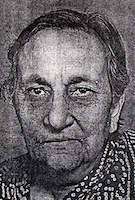
Ismat Chughtai was an Indian Urdu novelist, short story writer, liberal humanist and filmmaker. Beginning in the 1930s, she wrote extensively on themes including female sexuality and femininity, middle-class gentility, and class conflict, often from a Marxist perspective. With a style characterised by literary realism, Chughtai established herself as a significant voice in the Urdu literature of the twentieth century, and in 1976 was awarded the Padma Shri by the Government of India.

Urdu literature comprises the literary works, written in the Urdu language. While, It tends to be dominated by poetry, especially the verse forms of the ghazal and nazm, it has expanded into other styles of writing, including that of the short story, or afsana. Urdu literature is popular mostly in Pakistan, where Urdu is the national language, and in India, where it is an Eighth Schedule language.

Ahmed Ali was a Pakistani novelist, poet, critic, translator, diplomat and scholar. A pioneer of the modern Urdu short story, his works include the short story collections: Angarey (Embers), 1932; Hamari Gali, 1940; Qaid Khana, 1942; and Maut Se Pehle, 1945. His other writings include Twilight in Delhi (1940), his first novel in the English language.
The Progressive Writers' Association or the Progressive Writers' Movement of India or Anjuman Tarraqi Pasand Mussanafin-e-Hind or Akhil Bhartiya Pragatishil Lekhak Sangh was a progressive literary movement in pre-partition British India. Some branches of this writers' group existed around the world besides in India and Pakistan
Syed Sajjad Zaheer was a Pakistani and Indian Urdu writer, Marxist ideologue and radical revolutionary who worked in both countries. In the pre-independence era, he was a member of the Communist Party of India and the Progressive Writers' Movement. Upon independence and partition, he moved to the newly created Pakistan and became a founding member of the Communist Party of Pakistan.

Qurratulain Hyder was an Indian Urdu novelist and short story writer, academic, and journalist. One of the most outstanding and influential literary names in Urdu literature, she is best known for her magnum opus, Aag Ka Darya, a novel first published in Urdu in 1959, from Lahore, Pakistan, that stretches from the fourth century BC to post partition of India.

Ibn Sina Academy of Medieval Medicine and Sciences (IAMMS) is a trust registered under the Indian Trusts Act, 1882. Mohammad Hamid Ansari, former vice-chancellor of Aligarh Muslim University, Aligarh, formally inaugurated it on 21 April 2001. Department of AYUSH, Ministry of Health and Family Welfare, Government of India gave accreditation to the academy in 2004 and promoted it as 'centre of excellence' in 2008. Membership of the academy is open to anyone who has an interest in the academy's activities particularly on history of medicine and history of science. Being a charitable organization, donations to the Academy are also exempted from Income Tax under section 80G of the Income Tax Act 1961.

Begum Khurshid Mirza, also known by her screen name as Renuka Devi, was a Pakistani television and film actress during the pre-partition era.

Sheikh Abdullah, also known as Papa Mian, was an Indian educationalist, social reformer, lawyer, founder of Women's College, Aligarh and a member of the Executive Council of the Aligarh Muslim University who served to the post from 1920 to 1928. Later in 1902, he was appointed to the All India Muhammadan Educational Conference as a secretary for women's section. He is primarily known for his contribution to the Muslim women education during British India period.
Hamida Habibullah was an Indian parliamentarian, educationist and social worker. She has been called the iconic face of Indian womanhood in post-independence India.
Begum Masroor Jahan was an Indian novelist and short-story writer in the Urdu language. For her contributions to literature, she was awarded the Uttar Pradesh Urdu Akademi Awards in 2010 and 2015, and the Hindustan Times Women's Award in 2017.
Razia Sajjad Zaheer was an Indian writer in the Urdu language, a translator, and a prominent member of the Progressive Writers Association. She won the Uttar Pradesh Sahitya Akademi Award as well as the Soviet Land Nehru Award.
Hajrah Begum (1910-2003) was an Indian politician, leader of the Communist Party of India and the General Secretary of National Federation of Indian Women (NFIW) from 1954 to 1962.

Hamida Saiduzzafar was an Indian ophthalmologist.
Hamida Salim (1922–2015) was an Indian author, economist, and educator, writing primarily in the Urdu language. She was the first woman to graduate from Aligarh Muslim University.
Angarey or Angaaray is a collection of nine short stories and a one act play in Urdu by Sajjad Zaheer, Rashid Jahan, Mahmud-uz-Zafar and Ahmed Ali first published in 1932 and generally considered to have marked the beginning of the Progressive Writers' Movement in Indian literature. The release of the book was marked by protests and it was subsequently banned by the government of the United Provinces a few months after publication.
Noor Zaheer is an Indian left leaning feminist author. Zaheer is member of Delhi Urdu Academy chaired by Arvind Kejriwal.
Zair, Zabar, Pesh is a 1974 Pakistani television series written by Haseena Moin and directed by Ishrat Ansari and produced by Shireen Khan and Zaheer Khan.








